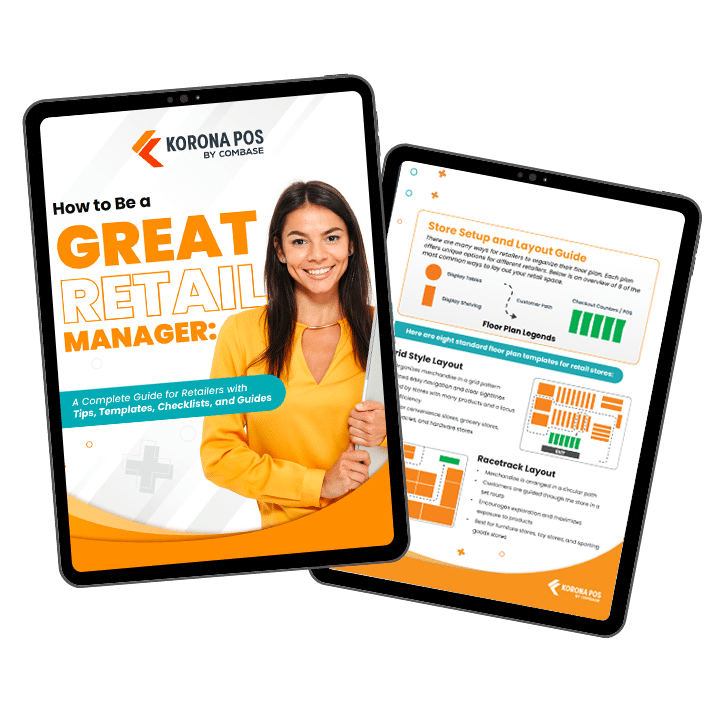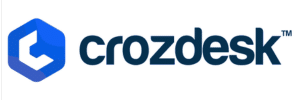Key Takeaways:
- Definition: Sell-through rate (STR) is the percentage of inventory sold over a period, calculated as (Units Sold ÷ Beginning Inventory) × 100.
- Why It Matters: The sell-through rate is how well products are moving.
- Healthy Range: Aim for 70-80% in most retail settings; below 40% indicates slow movers that require action.
- Varies by Context: Rates differ by industry (fashion: 80-90%, staples: 60-70%), season (holidays: 90%+, off-season: 50-60%), and channel (e-commerce often 5-10% higher than brick-and-mortar).
- Practical Use: Guides ordering, cuts storage costs, boosts cash flow, and sharpens promotions for better profits.
The sell-through rate, or STR, is a key metric for any retailer. It measures how quickly merchandise is selling and how efficiently stores are stocking and replenishing inventory.
In this blog post, we’ll explore the sell-through rate, how to calculate it, and the importance of having an accurate retail POS system to track it.
We’ll also explore what a reasonable sell-through rate is, the factors that influence it, and provide some tips on improving your sell-through rate.
Finally, we’ll discuss why understanding and optimizing your sell-through rate is critical to the success and growth of your business.
What Is Sell-Through Rate (STR)
The sell-through rate (STR) is a key metric used to measure the performance of a retail business. It’s an essential indicator of how well any product or collection is selling compared to other products or supplies. A higher sell-through rate means a better opportunity for generating higher profits.
The Importance of Sell-Through Rate
The sell-through rate is one of the most valuable metrics for retailers, as it indicates how efficiently products are moved from shelves into customers’ hands. A strong sell-through rate indicates healthy demand and smooth operations, while a weak rate often suggests inefficiencies or mismatched inventory. Understanding and improving sell-through brings several practical benefits:
Optimizing the Supply Chain
A good sell-through rate reveals which products are actually connecting with customers. By tracking it, retailers can identify which items deserve restocking and which ones should be phased out. Supply chains become leaner and more responsive.
Measuring Success Beyond Sales Volume
Sales volume alone doesn’t tell the whole story. A product might sell a lot, but still be overstocked compared to the original order. The sell-through rate provides context by showing how much of the inventory is actually selling at the expected pace. Retailers can use this to judge the effectiveness of promotions, merchandising, and product selection strategies.
Managing Cash Flow More Effectively
Excess inventory ties up cash that could be used elsewhere in the business. By maintaining a healthy sell-through rate, retailers free up capital more quickly, making funds available for reinvestment in new stock, marketing, or store improvements. Faster inventory turnover means healthier cash flow and greater financial flexibility.
Reducing Storage Costs and Waste
Unsold inventory occupies valuable space and often results in higher warehousing or in-store storage expenses. In categories such as fashion, electronics, or perishable goods, slow sell-through can also result in heavy markdowns or outright losses. A strong sell-through rate minimizes the burden of holding costs and reduces the need for deep discounting later on.
Strengthening Forecasting and Planning
Consistently tracking sell-through provides retailers with clearer insights into buying patterns. Over time, it sharpens demand forecasting, making it easier to plan future orders, adjust seasonal strategies, and set more accurate sales goals. Better forecasting translates into smoother operations and fewer costly surprises.
How to Calculate Sell-Through Rate? (Step by Step)
Calculating the sell-through rate is straightforward once you understand the formula.
Sell-Through Rate Formula
The formula is:
Sell-Through Rate = (Total Units Sold ÷ Total Inventory Available) × 100
- Total Units Sold = how many items you actually sold during a specific period.
- Total Inventory Available = the amount of stock you had at the beginning of that same period.
- The result is expressed as a percentage, making it easy to compare across different products, categories, or time frames.
👉 Example
- If you started with 100 items and sold 25, your sell-through rate is (25 ÷ 100) × 100 = 25%.
Sell-Through Rate Examples
Let’s put numbers to it with a few scenarios straight from the retail trenches. These examples illustrate how the formula applies across different products and periods—grab a calculator and follow along.
- Basic Monthly Check (Clothing Store): You start January with 200 sweaters in stock. By the end of the month, 140 have sold. Plug it in: (140 ÷ 200) × 100 = 70%. Solid rate—time to reorder confidently before February chill hits.
- Seasonal Push (Holiday Retailer): Heading into December, you’ve got 1,000 ornaments on hand. The frenzy nets 850 sales. Calculation: (850 ÷ 1,000) × 100 = 85%. Killer performance; scale up next year, but watch for post-holiday leftovers.
- Slow Starter (Electronics Shop): February begins with 150 phone cases. Only 45 move by end of month. (45 ÷ 150) × 100 = 30%. Red flag—consider a promo or bundle to juice it up and free shelf space.
- High-End Hit (Boutique): Launching a new handbag line, you stock 50 units. 42 fly out the door in the first week. Quick math: (42 ÷ 50) × 100 = 84%. This one’s a winner; double down on similar styles.
- Volume Game (Grocery Chain): Opening stock of 500 cereal boxes for the week. 425 get scooped up. (425 ÷ 500) × 100 = 85%. Steady as she goes—keeps cash flowing without waste.

Free printable templates and checklists to help you manage retail operations with ease
What is a Healthy Sell Through Rate?
Figuring out if your sell-through rate (STR) is in good shape isn’t one-size-fits-all—it depends on your industry, the time of year, and even how you’re selling.
Generally, retailers aim for a 70-80% inventory level as a sweet spot, where inventory moves steadily without excessive buildup or stockouts.
Anything below 40% often signals trouble, like overstocked duds that tie up cash. Here’s a breakdown of what “healthy” looks like in different scenarios, with practical benchmarks to guide your checks.
- Industry Benchmarks for Retail Categories: Different sectors have their own rhythms. Fashion might chase 80-90% to keep trendy items fresh, while big-box staples hover around 60-70% for steady turnover. Overall, the average across retail lands between 40-80%, but hitting that upper end keeps things profitable. Track yours against these to spot if a category’s lagging, like electronics at 50-70% where tech cycles move slower.
- Seasonal Variations: Holiday Peaks vs. Off-Season Slumps: Expect big swings—holiday rushes can push STR to 90%+ as shoppers snap up gifts, turning your stock into quick wins. Off-season? It might dip to 50-60%, especially for seasonal gear like swimsuits in winter. Plan ahead by stocking leaner during lulls to avoid markdown marathons later.
- E-Commerce vs. Brick-and-Mortar Differences: Online channels often outperform physical stores with STRs 5-10% higher, thanks to data-driven stocking and flash sales that clear inventory faster. eCommerce grew 5.3% in 2024, while brick-and-mortar stores reached 3.5%. In-store, tactile shopping can boost impulse buys but leads to higher returns (up to 30% compared to e-commerce’s lower overhead), so aim for 65-75% there to match the omnichannel vibe.
- Factors That Can Shift Your Target Rate: Product type matters—perishables require a rate of 90% or higher to minimize waste, while durables like furniture are acceptable at 50%. Economic vibes also play a role; in a tight 2025 market, even strong performers might ease to 60-70% without feeling off. Watch for these to adjust expectations without overreacting to a single dip.
- Red Flags and Quick Wins for Improvement: If you’re below 40%, it’s time to promo, bundle, or cull—healthy rates fuel cash flow, so use tools like POS dashboards to tweak on the fly. Celebrate 80% or higher as your green light for scaling up winners.
Strategies to Improve Sell-Through Rate: Tips & Techniques
You may wonder what actionable steps you can take to increase your STR and make smarter business decisions. Fortunately, there are plenty of tried and tested techniques that you can use to improve your STR and maximize the profitability of your business.
Lower inventory levels
One of the most effective ways of improving your STR is to maintain lower inventory levels. Keeping track of current consumer trends is crucial when restocking items, as overbuying could easily lead to stockpiles of unsold products, lowering your STR in the long run.
Inventory management a headache?
KORONA POS makes stock control easy. Automate tasks, generate custom reports, and learn how you can start improving your business.
Run promotions
Running promotions is another way to increase demand for specific items in your store. You can offer discounts or free shipping on items with a lower sell-through rate to entice shoppers. Additionally, you could organize customer loyalty programs that encourage repeat customers and reward them for their purchases.
Examine seasonality
It’s essential to monitor seasonality trends when predicting demand for specific products. For example, if you own a clothing store, you’ll want to stock up on winter coats at the beginning of the fall and then plan your promotions accordingly so that you don’t end up overwhelmed with inventory come springtime.
Ask your customers
The best way to gain insight into what customers are looking for is to simply ask them. You can conduct surveys or questionnaires online or in-store, or have employees engage with customers directly so that you can get as much insight as possible into their buying habits. This will help you determine what items should be stocked to maximize your STR.
Common Sell-Through Rate Mistakes
A sell-through rate (STR) helps businesses measure the percentage of inventory sold versus the amount received from a vendor. While a simple calculation, mistakes are common and can skew the results. Here are some of the most frequent errors:
Ignoring promotions and discounts: A huge mistake is calculating STR without accounting for items sold at a discounted price. Doing that can inflate the true value of your inventory and lead to inaccurate forecasts.
Inaccurate initial inventory count: Many retailers fail to conduct a precise initial inventory count, which forms the basis for the STR calculation. An error compromises the integrity of all subsequent data.
Poor POS data: POS systems are crucial for tracking sales, but if not properly configured or maintained, they can lead to significant data discrepancies. Incorrect data input, such as unrecorded sales or misclassified items, can misrepresent STR, resulting in inventory discrepancies.
Get started with KORONA POS today!
Explore all the features that KORONA POS has to offer with an unlimited trial. There’s no commitment or credit card required.
Forgetting to account for returns and damaged goods: Failing to subtract returns and damaged merchandise from your total sales can artificially inflate your STR, creating an overly optimistic picture of your inventory’s performance.
Role of Retail POS Systems in STR Optimization
When integrated with the right point of sale, businesses can track sales data, customer behavior, and inventory.
Calculating KPIs and other metrics
Using a POS system also makes it easier to calculate the sell-through rate. The software can collect data from all sales channels and generate detailed reports that display metrics such as units sold and units in inventory over time. This information can be used to calculate the STR for any given time period and compare it to other periods.
Understanding sales trends
Using a POS system also makes it easier to improve your sell-through rate by identifying trends in customer behavior and helping you target the right audiences for your products. Additionally, a POS system’s ability to manage inventory in real-time enables businesses to quickly identify slow- or obsolete-selling items, allowing them to adjust their strategies accordingly.
Plan ordering with predictive sales analysis
A POS system can also be used to identify trends in customer demand and adjust the product inventory accordingly. It enables the retailer to target specific high-demand items and ensure their stores are well-stocked with popular products. Furthermore, sales projections based on historical data can be used to predict future demand and ensure that business operations remain effective.
Overall, a retail point of sale system provides invaluable insights into sales trends. It is essential to leverage this data to optimize your sell-through rate and maximize your profits.
Sell-Through vs. Inventory Turnover
Another metric closely related to the sell-through rate is the inventory turnover ratio (ITR). Both of these metrics measure the efficiency of customers buying products and stores selling them. While STR provides information on total sales for total inventory within a particular period, inventory turnover, on the other hand, measures how many times a company’s inventory is sold and replaced over time.
It is calculated by dividing the cost of goods sold by the average inventory value for the same period. The inventory turnover ratio is a key indicator of a company’s operational efficiency, used to assess how effectively the company manages its inventory levels and cash flow.
Both metrics are important to track for a company’s inventory management. However, they serve different purposes. The STR measures how quickly inventory is being sold, while the inventory turnover measures how often inventory is being replaced. A high STR with low inventory turnover indicates that the company is selling inventory quickly but may be carrying too much inventory.
Inventory management a headache?
KORONA POS makes stock control easy. Automate tasks, generate custom reports, and learn how you can start improving your business.
See How KORONA POS Can Enhance Your Sell-Through Rate
KORONA POS can enhance your sell-through rate by offering inventory tracking and advanced analytics that help you pinpoint which products are performing well and which aren’t. With automated reorder points and stock-level alerts, you can maintain optimal inventory levels.
Additionally, KORONA POS offers detailed sales performance reports and customer insights. You can analyze product trends by location, season, or category, and use that data to adjust your inventory mix and marketing strategies for maximum turnover. Click below to get started with KORONA POS.
Speak with a product specialist and learn how KORONA POS can power your business.












